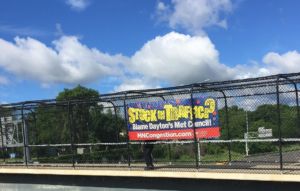It’s Time To End the Twin Cities’ Congestion Crisis
“Stuck in Traffic? Blame Dayton’s Met Council!” That’s the message on American Experiment’s six electronic billboards scattered around the Twin Cities’ freeway system for another week or so.
If you’re a subscriber to the Center’s “Thinking Minnesota” magazine in the metro area, your newest edition currently in the mail likely contains a bumper sticker bearing the same theme.
Also listen up for our radio spots on popular local Twin Cities stations that use humor to remind folks that the metro region’s traffic congestion crisis is no accident. You may even have seen our banner during rush hour on an overpass on I-394.
It’s all part of our Government Accountability Project to drive up awareness of why the Twin Cities faces a worsening traffic tie-up problem and what can be done to help get commuters to and from home and work more efficiently.
We hope you agree that it’s “Time to End the Congestion Crisis” and help spread the word by sharing columns like this one from the Shakopee Valley News.
Some things are beyond our ability to control. No matter how bad it gets, there’s nothing that we can do about the weather, stock market or inflation.
Many Twin Cities residents undoubtedly lump traffic congestion into the same category and view bumper-to-bumper gridlock on metro freeways as a given.
Understandably so. Congestion continues to explode, quadrupling since 1982 locally, national traffic statistics show. The aver age Twin Cities commuter today wastes 47 hours a year — more than a full workweek — stuck in traffic jams, up from 12 hours per year in 1982.
The estimated cost in wasted time, wasted fuel and pollution from drivers and vehicles bogged down on the freeways totals nearly $4 billion a year to the regional economy.
Center of the American Experiment’s new report on the cause and effect of Twin Cities traffic congestion reveals it doesn’t have to be this way. “Twin Cities Traffic Congestion: It’s No Accident” argues the level of traffic congestion the Twin Cities put up with is a choice, rather than an inevitable fact of urban life. (Download the report at www.MNCongestion.com.)
Rather than focusing on comprehensive congestion relief, the state agencies responsible for the transportation system — the Met Council and MnDOT — often pursue policies that make the problem worse, our 24-page study shows.
Without question, declining gas tax revenues, inflation and other factors have resulted in the underfunding of highways. But a policy shift away from reducing congestion under the Dayton Administration has also had great consequences for Twin Cities commuters.
In fact, the Met Council and MnDOT specifically disclaim relieving traffic congestion as a priority.
“The council recognizes that congestion will not be eliminated or significantly reduced in the Metropolitan Area,” the Met Council’s 2030 transportation plan states.
“Since 2010, MnDOT’s strategy has shifted from reducing congestion toward providing alternatives to congested travel,” according to the agency’s latest Annual Minnesota Transportation Performance Report.
Critics claim building more highway miles ultimately leads to more vehicles on the road, providing little in the way of congestion relief. But an aggressive construction program that expanded the number of Twin Cities freeway lane miles by 23 percent between 2004 and 2010 helped reduce delays for the average commuter by 10 percent.
While the recession may also have been a factor, the number of commuters actually grew by 13.5 percent, meaning the increase in freeway lanes made a decisive difference in helping commuters get to their jobs and families more efficiently.
Yet since then, the Met Council and MnDOT have done a U-turn on increasing lane capacity.
The Met Council’s 2040 transportation plan calls for spending 37 percent of transportation funding ($31.2 billion) on transit that accounts for just 1.5 percent of passenger miles in the metro area.
Worse yet, the Minnesota State Highway Investment Plans prepared by MnDOT have slashed the amount dedicated to congestion relief from 7 percent of funding in 2009 to just 1 percent in the 2017 plan. MnDOT proposes to spend $700 million on bike and pedestrian infrastructure over the next 20 years and only $265 million on mobility improvements for cars.
No wonder MnDOT’s most recent traffic study shows congestion rose to a higher level in 2015 than any year since the agency began measuring in 1993 and predicts the problem will only get worse. At the same time, numerous polls have found Twin Cities residents consider congestion to be among the region’s most serious problems.
But the 2017 legislative session resulted in a change of direction that should provide hope to frustrated commuters. State lawmakers passed legislation signed by Gov. Dayton that adds $5 billion in transportatio n funding over the next decade.This funding sends a message to the Met Council and MnDOT that congestion relief needs to become a priority once again.
Tom Steward reports on government accountability issues at Center of the American Experiment in Golden Valley.